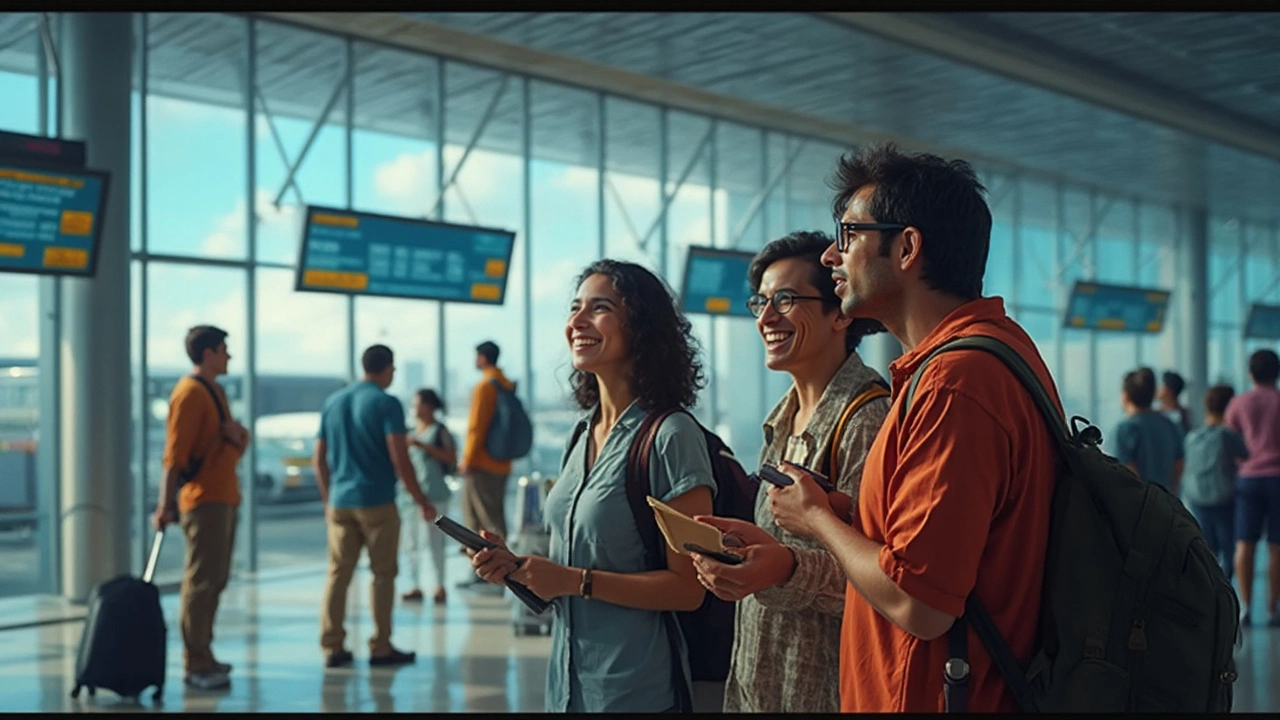Time is money, but when you’re stranded in an airport feeling like a zombie at 3 a.m., the real question is: can you ditch that uncomfortable seat and crash in a proper hotel during your layover? Airports worldwide look like mini-cities, but nothing replaces a real bed and a steaming shower, especially if you’re on a long-haul route or stuck with kids who treat it like another round of tag. Most people don’t know you actually have a lot more freedom than you think. Rules exist, yes, but there’s an art to tackling layover logistics and sneaking off to a cozy duvet.
Understanding Airport Layover Rules: Can You Really Leave?
The short answer: sometimes. The longer answer? It depends on more than a few things. Your passport, your tickets, the amount of time you have, and the country you’re in can all flip the script. Domestic layovers are usually easy: if you land in the U.S. and your next flight is several hours away, you just head out, stay where you want, and bounce back through security later. There’s no passport check once you’re inside the country. It gets trickier the moment you cross borders. International layovers sometimes mean a mountain of paperwork and a juggling act between passport control and visa rules. Some countries are flexible; others clamp down hard.
If your layover is in the European Union—let’s say Paris or Frankfurt—your ability to leave hinges on whether you already entered the Schengen Area. Most travelers with valid visas or visa-free entry can leave the airport, stay overnight somewhere nearby, and re-enter for their next flight, as long as they go through security and passport control again. In places like Dubai or Singapore, you might be allowed to leave, but a transit visa could be required—even if you’re just popping out for four hours. Others, like China, now offer short-term transit visas on arrival in select airports. A lot of people miss this and wind up sleeping on a plastic chair instead of a soft pillow.
Rule of thumb: Check the official immigration website of wherever you’re changing planes. Ignore random anecdotes from forums—customs does not care that your cousin managed it last time. You risk being detained, missing your next flight, or even being denied re-boarding, if you break the rules. Read what your ticket says, too—some flights involve self-transfer, meaning you have to recheck your bags and clear security yourself, which eats up precious nap time.
Risks, Surprises, and Common Pitfalls When Leaving the Airport
Let’s get real—no one likes drama at the airport. Yet, even with the best plans, people get burnt by the little details. The #1 mistake? Cutting it too close. Most travel nightmares happen because folks think a four-hour layover is enough cushion for a little sightseeing or a hotel nap. Airport security lines can turn wild, especially during international flights, and traffic jams outside big airports are legendary. If your connection’s tight, any tiny delay could get you stranded. There are airports where clearing customs or security can blow through over an hour, even at weird times of the night.
If you’re traveling with checked bags and you want to leave during a layover, you need to check your baggage tag. Is your luggage checked to your final destination, or do you need to grab it and recheck? If you need to collect your bags, that chews heavily into your escape time. Some airlines don’t through-check bags across certain alliances—something I learned the hard way on a 17-hour layover in Istanbul. It’s not fun to haul a suitcase through two sets of passport lines just to take a three-hour shower before reconnecting.
Visas are another tripwire. Not every country offers easy transit options. The U.S. doesn’t have a transit visa system; you need a regular visa or ESTA if you plan to leave the airport, no matter how short your visit. The UK used to have the “airside transit” option, but plenty of passport holders now need a full visa to leave Heathrow or Gatwick’s secured areas. Some places require you to book your hotel through their authorized list or even prove onward travel. Singapore, Qatar, and Seoul have wild layover tours you can join, but if you wander by yourself, you might need to fill forms or leave your passport at a check-desk. Don’t think border guards will pity you if the traffic back to the airport makes you late.
Kids add a layer. If you’re like me, with a son named Rowan who gets antsy in crowds, keeping him corralled at security is already a battle. Add an unexpected layover hotel run, plus wrangling with child travel documents, and chaos can bloom fast. Always bring extra copies of birth certificates or IDs for under-18s, even if the airline “doesn’t require it.”

Expert Tips for Booking Hotel Stays During a Layover
Sleeping in airports made “the floor is lava” a real experience. Booking a hotel nearby—or inside—the airport feels like cheating, but trust me, it’s worth every cent, especially on long hauls or with cranky kids. The easiest option? Many major airports have transit hotels inside the secure zone, so you never need to clear customs. If you can get a room at those (think Yotel in Schiphol, or the Aerotel in Singapore), you’ll pass through a private security line in the morning and walk straight to your gate, no sweat.
But sometimes those hotels are full or your airport doesn’t offer one. Next best thing: look for hotels that offer a free shuttle. Not all airport hotels are walking distance—some are a 10- to 25-minute van ride, and during peak travel hours, shuttles might fill up. Always double-check the shuttle schedule, and allow for delays both on pickup and the way back. Some hotels require you to call upon arrival, and if your phone doesn’t work overseas, you could be stuck waiting. I always screenshot directions, shuttle timetables, and confirmation emails before my flight.
Booking platforms like Booking.com now have a “transit hotel” filter, making it easier than ever to spot options that line up with your layover window. Many airport hotels now sell day-use rooms—no need to book a full night if you just want a nap and a shower. If your layover is crazy short (anything less than six hours), a sleep pod or capsule hotel inside the terminal often makes more sense. They’re popping up in places like London, Tokyo, and Doha, and you pay by the hour for a quiet private space. Don’t overlook airport lounges, either; some offer sleeping rooms or good rest facilities for less than some hotel rates.
If you want to explore the city, stash luggage with a hotel concierge or luggage storage service before heading out. A bagless stroll is a happier one, believe me. And before you book independently, check if your airline offers a stopover program. Emirates, Turkish Airlines, and Air Canada sometimes pay part—or all—of your hotel night if you have a long enough layover. Just ask at the check-in or transit desk—worst case, they say no, best case, you’re getting pampered on their dime.
What You Should Always Do Before Leaving the Airport
There are things you can wing in travel, but leaving the airport during a layover isn’t one of them. Here’s what I always run through before I make my escape plan. First, count your connection hours—not just scheduled, but accounting for possible delays. My hard rule: never leave the airport unless I have at least 6 to 8 hours between flights, and I pad time for worst-case scenarios like bad weather, strikes, or notorious traffic jams. Five hours might look fine on paper, but a single hiccup can wipe your margin for error.
Second, research the specific airport. Some, like Changi or Incheon, are built for layovers, loaded with services for travelers, including clear signs guiding you to and from customs. Others, like LAX or JFK, are less forgiving, and even returning from a hotel shuttle can mean long re-entry security waits. The U.S. in particular has a reputation for slow lines and unpredictable screening times, so always read recent traveler reports on line length and local quirks. This is not the place to get caught off guard.
Visa requirements: triple check them. Don’t rely on airline staff having the latest info—rules shift quickly. This year alone, countries like Australia, Brazil, and India made changes to transit visa rules at select hubs. Government embassy sites or official airport pages are the only sources I trust. And if you get pre-cleared by customs officers or need special stamps for reentry—get those going out, not when you return in a rush.
Keep all your documents handy, including travel insurance and emergency contacts. Your phone should be fully charged before leaving the airport, and get a note of the airport wifi password and local transport options, just in case you need to change plans on the fly. I always pin hotel and airport locations on Google Maps in advance, so if my mobile data flakes, I’m not lost somewhere between a freeway and a parking lot.
Finally—the return journey. Factor in time for shuttle pickup, traffic, reentry security, and check-in. I always leave my hotel two to three hours before the next takeoff, even if it means a short nap. The risk isn’t worth chancing a missed connection. If you’re traveling with family like me, team up—one keeps the kids organized, while the other double-checks documents and bags. When you finally board that second flight, rested and showered, you’ll forget the stress and just enjoy the journey. Or, if there’s drama, at least you’ll have a story to tell.
